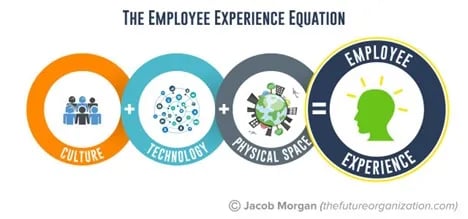I have a confession to make: I wish I read more. Between running a fast-growing company and a busy family life that includes two young kids, I have little time left. I do prefer non-fiction books, particularly if I can apply the concepts to my business. A close friend of mine recently recommended – “The Employee Experience Advantage: How to Win the War for Talent by Giving Employees the Workspaces They Want, the Tools They Need, and a Culture They Can Celebrate” by Jacob Morgan.
For the last 13 years, I have built several businesses focused on the employee experience. I am a firm believer that HR needs to morph into something else and this change is already happening. For the last 10 years, HR has moved in many organizations from being policy driven to focus on transforming employees, about filling them with purpose and creating the culture to make them feel that the company is truly their home. New HR platforms are providing real time data facilitating this shift.
I believe that HR needs to focus on creating an environment where people are excited to come to work. An environment in which Monday is not a swear word. At one of my recent companies, DevFacto Technologies, we went as far as creating a simple equation to represent the value of our employee experience – “Happy Employees = Happy Clients.”
We then defined what makes employees happy as:
- Having a culture that foster career and personal growth
- Belonging to a tribe of likeminded individuals
- Having a great working environment
- Having the right tools for their job
Jacob’s Employee Experience Equation from the Employee Experience Advantage Book is a model that I really like. It’s culture + technology + physical space = employee experience.

The Employee Experience Equation by Jacob Morgan
Interestingly, the three parts making up Morgan’s equation are not weighted equally. Culture carries the most weight, at approximately 60%, followed by physical space (23%), and technology (17%).
How has COVID-19 changed this equation?
COVID-19 has introduced significant challenges to the employee experience. A remote culture is harder to foster and maintain than an in-person one. Casual interactions are non-existent, from employee lunches, watercooler talk, or simply bumping into someone in the hallway. These seemingly unimportant interactions created the fabric that held together most organizations’ culture.
Like most of us, my physical space for the last 13 months has been my house. All the investment in our office space has gone unused for over a year now. This has truly challenged us on how we maintain and improve the culture we carefully built.
According to most polls, a growing number of companies are considering allowing their employees to work remotely indefinitely or will have more remote workdays, typically around three days a week. Some giants who appeared to be all-in for permanent remote work seem to have reverted back to expecting full-time in office behavior. (See this article about Amazon)
Full or part-time remote work will likely reduce the influence of physical space (23%) in the employee experience equation. In a virtual office space environment, technology’s influence will also increase and become more significant.
I believe this will be particularly true for mid-size organizations. Organizations in the mid-market have not invested as much on employee communications technology. They relied on in-person interactions that have been non-existent for quite some time, and new remote-first habits and engagement is still not the norm.
Now’s the time to think through making the shift and investing in your organization’s culture and technology. Your company likely plans to reduce its physical space requirements in the years ahead. This will represent significant savings, but I would argue that there has never been a more critical time to divert some of those savings and invest into internal communication technology. You need to effectively communicate with your entire workforce and improve your corporate culture in a virtual world.
Conclusion
As the title of the book states, the employee experience starts with giving employees the workspaces they want, the tools they need, and a culture to celebrate. Going forward organizations that want to win the war on talent are absolutely going to have to focus on accessible and inviting technology as much as the workplace environment. This will make it easier and more emotionally worthwhile for your workforce to be willing to take the time and engage. Doing this will transform your people into evangelists of the company and put them into a much higher state of productivity. Surveys show that this will bring down attrition as well as attract top talent – because who doesn’t want to be on a winning team?
At the end of the day, what we need to do to have key employee experience advantage is clear, so why are so few doing it? Well, that’s an article for a different day.
Are you ready for a modern, vibrant communication platform? We’d love to introduce you to Sparrow.
 If you’re looking for a platform to help make your life easier and connecting you with all of your workforce, give Sparrow a look. We’ve lived the pain, we understand the hopes, and we built a platform for communication professionals that delivers. From Intranets, to Microsoft Teams, to newsletters, email and mobile, we know how important corporate communications is. Sparrow – Built for Communicators. Book a conversation with us today.
If you’re looking for a platform to help make your life easier and connecting you with all of your workforce, give Sparrow a look. We’ve lived the pain, we understand the hopes, and we built a platform for communication professionals that delivers. From Intranets, to Microsoft Teams, to newsletters, email and mobile, we know how important corporate communications is. Sparrow – Built for Communicators. Book a conversation with us today.







